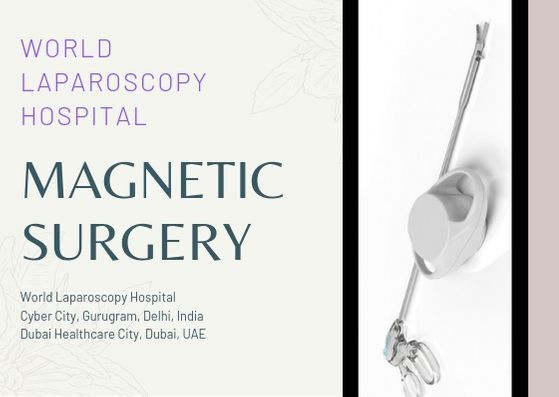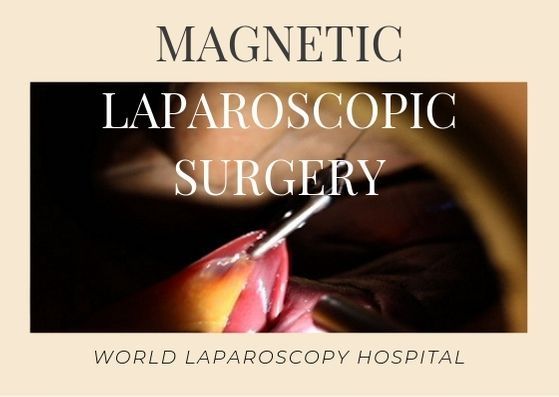
Surgery is an essential medical procedure that is used to treat a wide range of medical conditions. Over the years, advancements in technology have led to the development of new surgical techniques that are less invasive and result in fewer scars and incisions. One such technique is Magnetic Assisted Laparoscopic Surgery (MALS), which uses magnetic fields to guide surgical instruments and reduce the number of incisions and scars. In this essay, we will explore how MALS works and its benefits over traditional laparoscopic surgery.
Magnetic Assisted Laparoscopic Surgery:
Magnetic Assisted Laparoscopic Surgery is a minimally invasive surgical technique that uses magnetic fields to guide surgical instruments through the body. The procedure involves placing a small magnet inside the patient's abdomen near the area that needs to be operated on. The surgeon then uses an external magnet to guide the surgical instruments through the body without making large incisions.
The external magnet is placed outside the patient's body and is controlled by the surgeon. The magnet creates a magnetic field that passes through the patient's body and interacts with the internal magnet. This interaction causes the internal magnet to move, which in turn moves the surgical instruments. The surgeon can control the movement of the instruments by adjusting the external magnet.
Benefits of Magnetic Assisted Laparoscopic Surgery:
Magnetic Assisted Laparoscopic Surgery has several benefits over traditional laparoscopic surgery. One of the primary benefits is that it reduces the number of incisions and scars. Traditional laparoscopic surgery requires several small incisions, each of which leaves a scar. MALS only requires one small incision, which results in a single scar. This is beneficial for patients who are concerned about the cosmetic appearance of their scars.
MALS also reduces the risk of complications associated with surgery. Traditional laparoscopic surgery requires the surgeon to make several incisions, which increases the risk of infection, bleeding, and other complications. MALS only requires one small incision, which reduces the risk of complications.
MALS is also less painful than traditional laparoscopic surgery. Traditional laparoscopic surgery can cause significant pain and discomfort, especially during the recovery period. MALS is less invasive, which means that patients experience less pain and recover more quickly.
Another benefit of MALS is that it allows for more precise surgery. The magnetic field created by the external magnet allows the surgeon to guide the surgical instruments with more precision. This is especially beneficial for surgeries that require a high level of precision, such as surgeries on delicate organs.
MALS also has a shorter recovery time than traditional laparoscopic surgery. Patients who undergo MALS can typically return to their normal activities within a few days, whereas patients who undergo traditional laparoscopic surgery may need several weeks to recover fully.
MALS has been used in a variety of surgeries, including gallbladder removal, hernia repair, and colorectal surgery. The use of MALS has resulted in shorter hospital stays, reduced recovery times, and improved outcomes for patients. The technique is also cost-effective, as it reduces the need for multiple surgical instruments and reduces the risk of complications.
One of the challenges associated with MALS is the need for specialized equipment and trained personnel. Not all medical facilities have the necessary equipment and personnel to perform MALS, which can limit its availability. However, as the technology continues to advance, it is expected that more medical facilities will adopt MALS and make it more widely available.
In addition to reducing the number of incisions and scars, MALS also has the potential to reduce the risk of complications associated with surgery. The use of magnetic fields to guide surgical instruments reduces the need for the surgeon to manipulate organs or tissues, which can reduce the risk of damage to surrounding structures. This can be especially beneficial in surgeries that involve delicate organs or tissues, such as the pancreas or liver.
Another potential benefit of MALS is its use in robotic surgery. Robotic surgery is a minimally invasive surgical technique that uses robots to perform surgery. The use of MALS in robotic surgery can improve the precision and accuracy of the surgical instruments, making robotic surgery even more effective.
MALS is also being used in pediatric surgery. Children are particularly vulnerable to the risks associated with surgery, such as infection, bleeding, and damage to surrounding structures. The use of MALS in pediatric surgery can reduce these risks and improve outcomes for children. The technique is especially beneficial in surgeries that require a high level of precision, such as surgeries on the liver or pancreas.
MALS has also been used in bariatric surgery. Bariatric surgery is a surgical procedure that is used to treat obesity. The procedure involves reducing the size of the stomach or bypassing a portion of the small intestine to reduce the amount of food that the patient can eat. MALS can be used in bariatric surgery to reduce the number of incisions and scars and improve outcomes for patients.
One of the potential limitations of MALS is the need for specialized training. Surgeons who perform MALS require specialized training to use the magnetic fields to guide surgical instruments through the body. This can be a challenge for medical facilities that do not have the necessary equipment or personnel to provide this training.
Another potential limitation of MALS is its cost. The equipment required to perform MALS can be expensive, which can limit its availability in some medical facilities. However, as the technology continues to advance and become more widely adopted, it is expected that the cost of MALS will decrease, making it more accessible to patients.
In conclusion, Magnetic Assisted Laparoscopic Surgery is a minimally invasive surgical technique that uses magnetic fields to guide surgical instruments through the body. The technique has been used in a variety of surgeries, including pediatric surgery and bariatric surgery, and has been shown to reduce the number of incisions and scars and improve outcomes for patients. The technique requires specialized training and equipment, which can limit its availability in some medical facilities. However, as the technology continues to advance, it is expected that MALS will become more widely available and be used in an increasing number of surgical procedures






